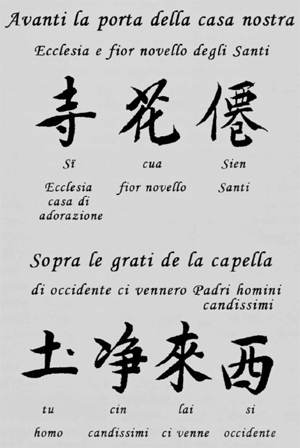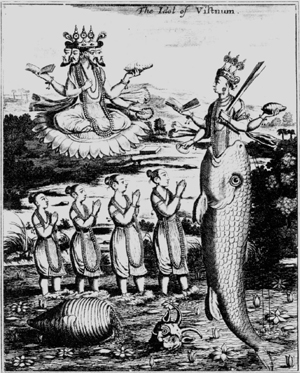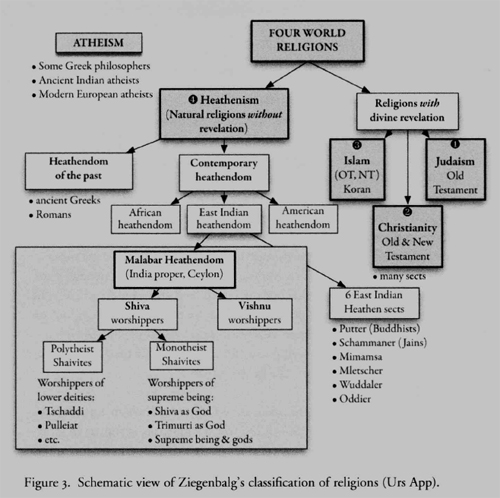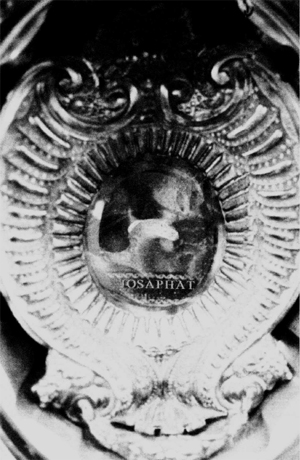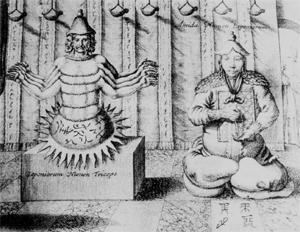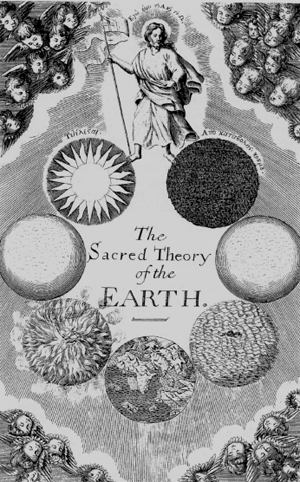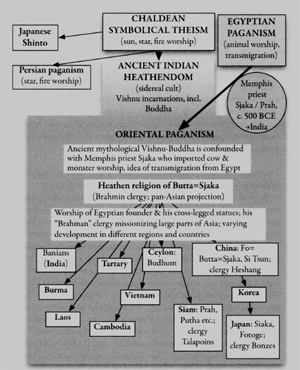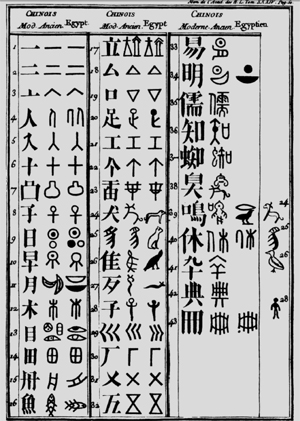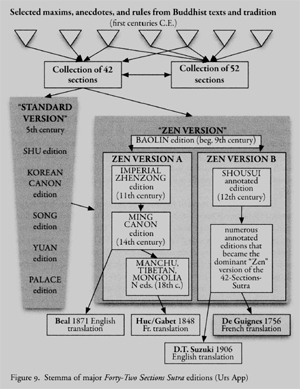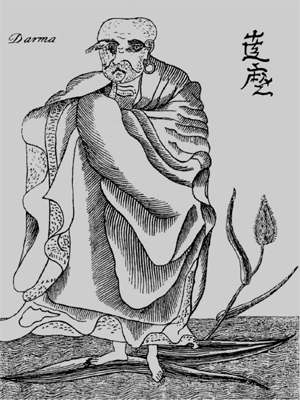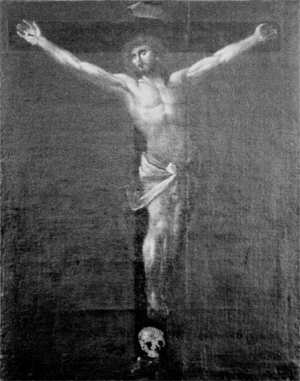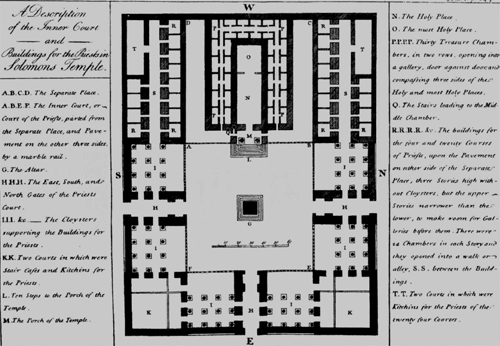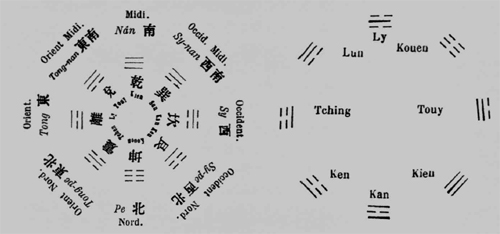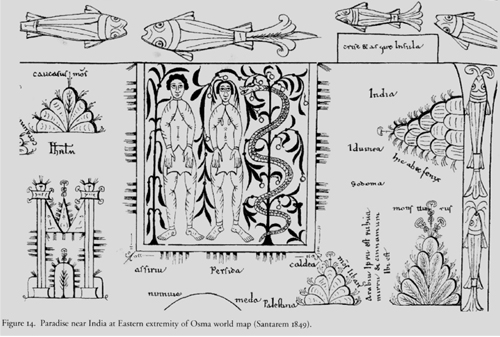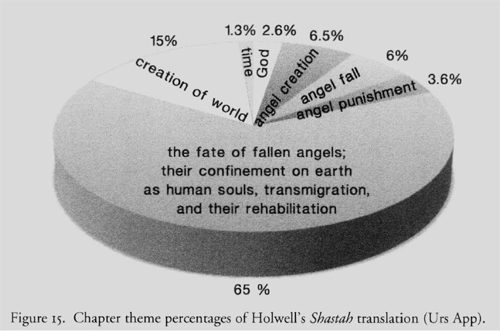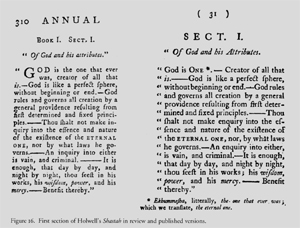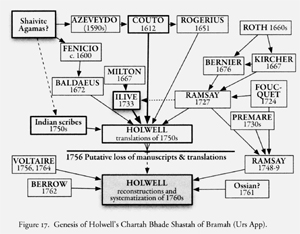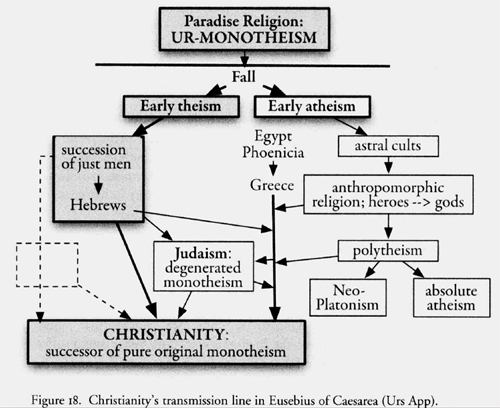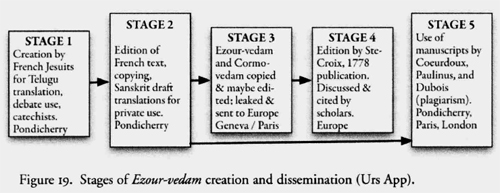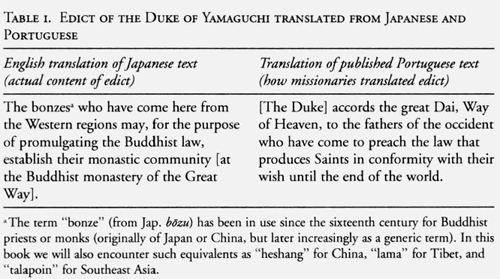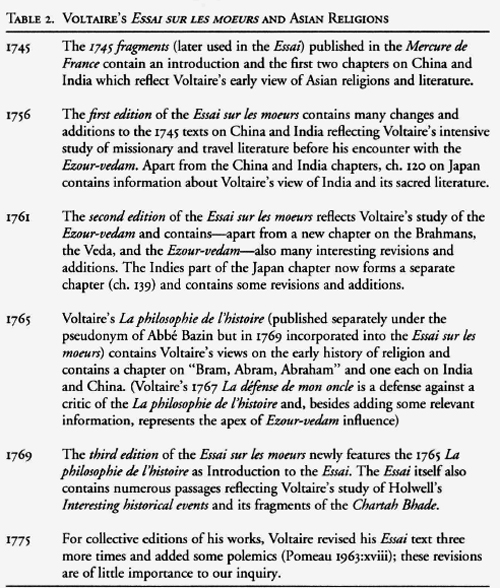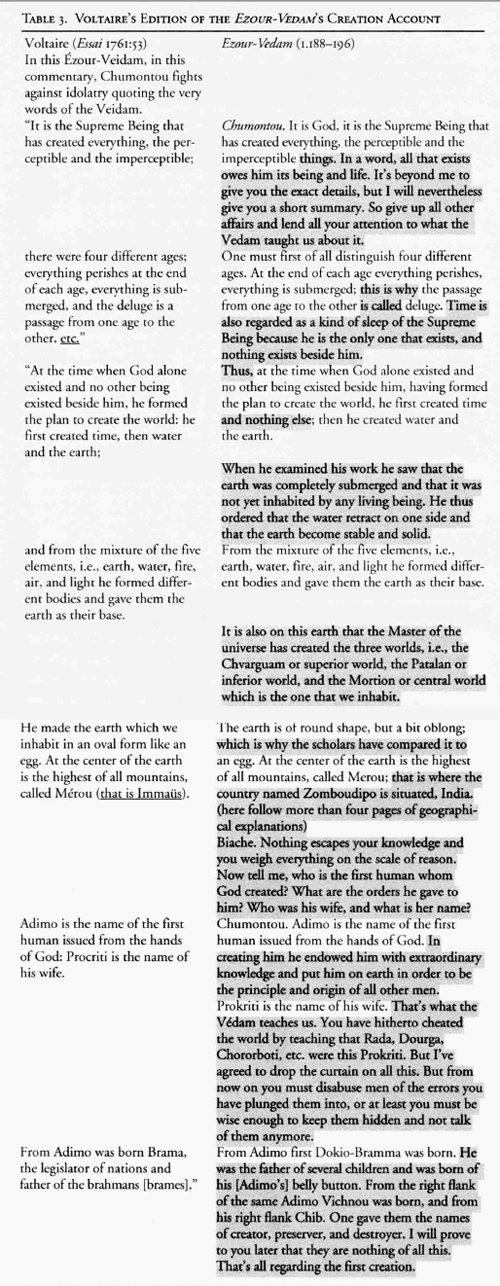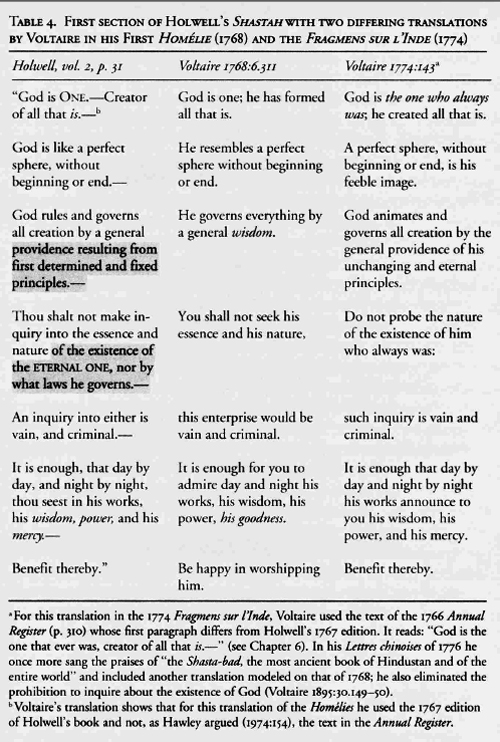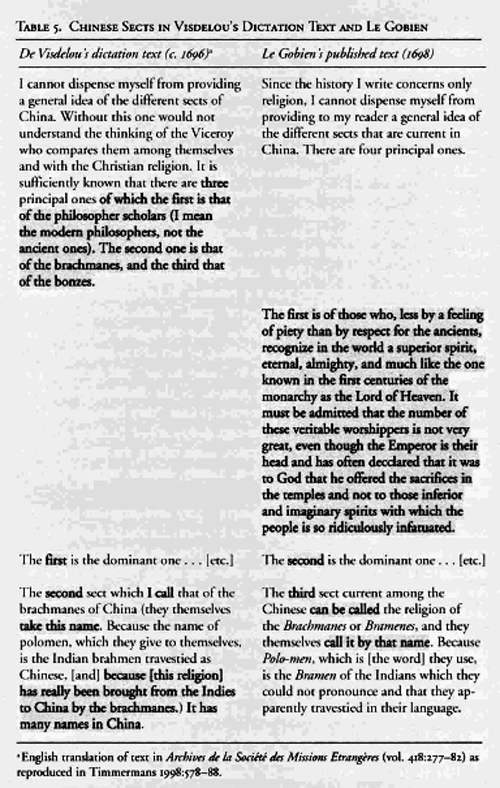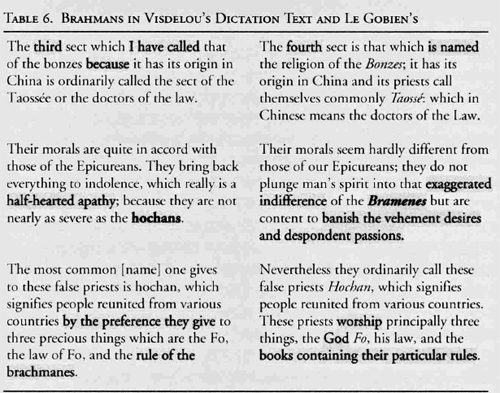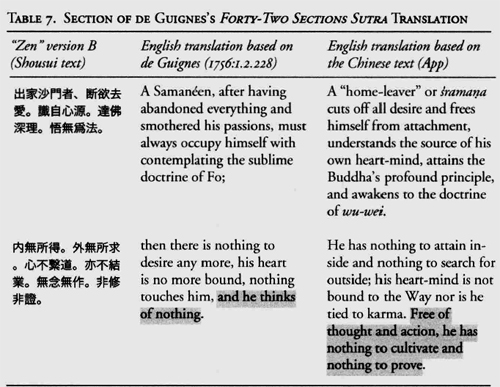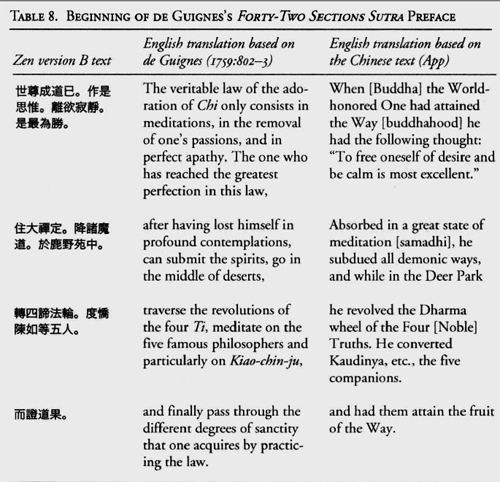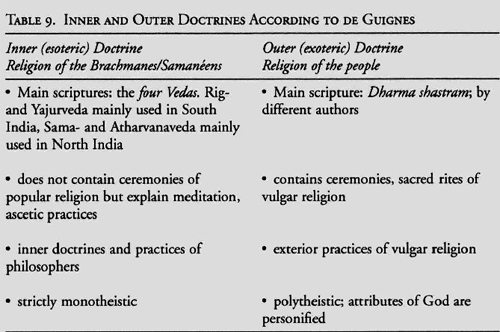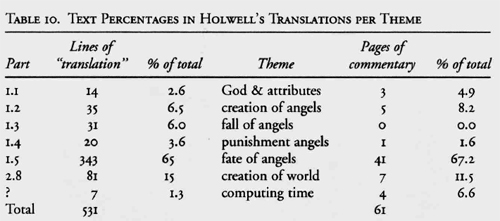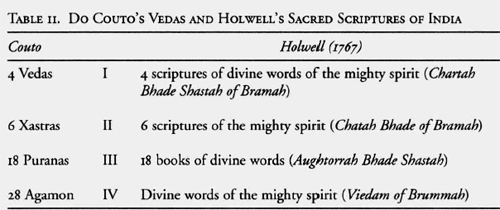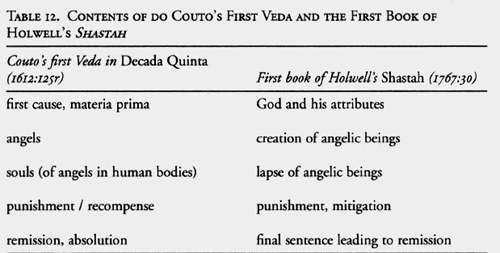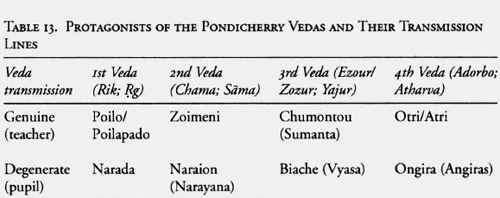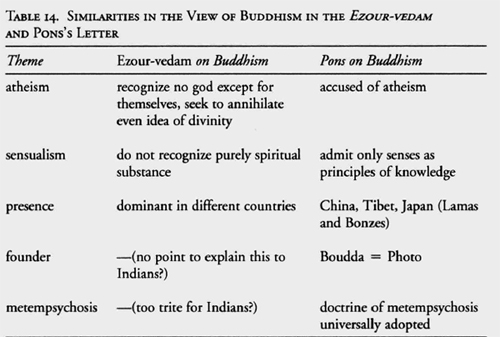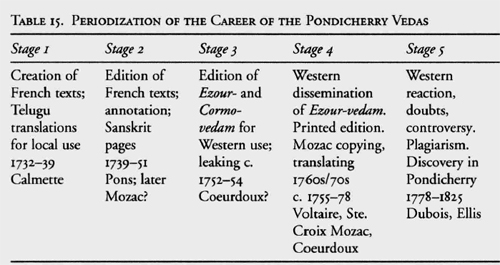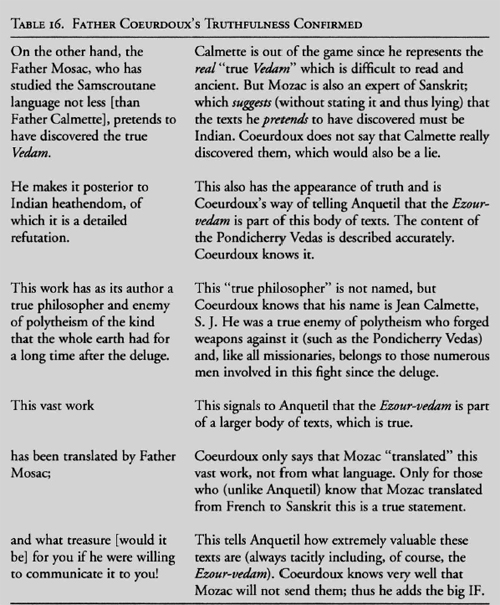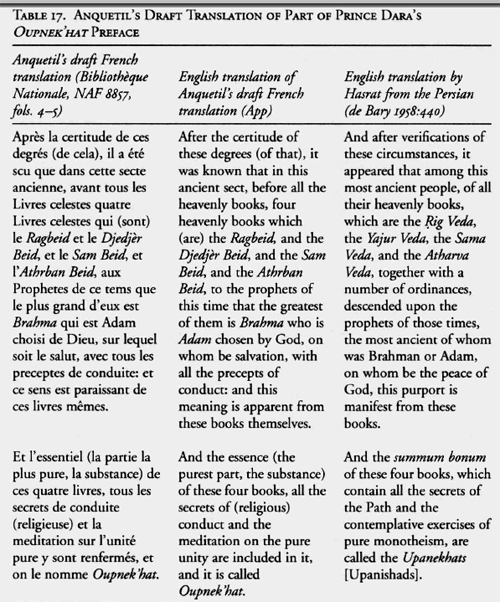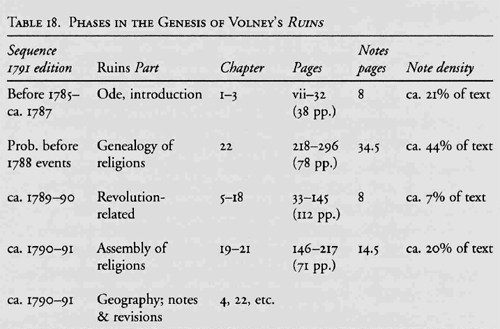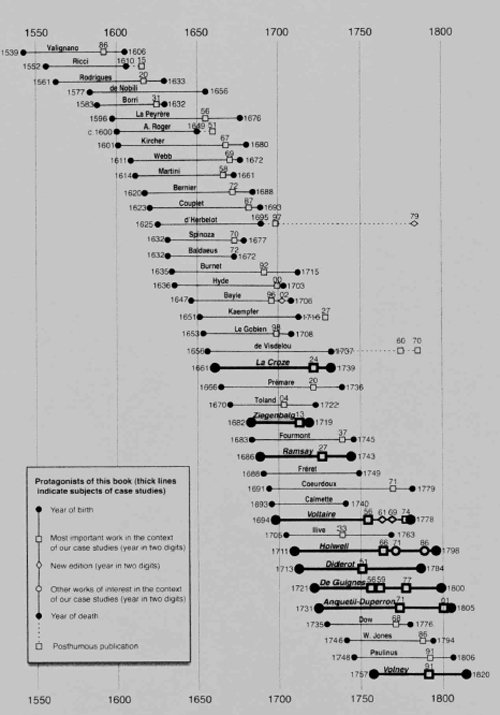
Notes
PREFACE
1. Urs App, "William Jones's Ancient Theology," Sino-Platonic Papers 191 (July 2009).
2. Needless to say, these translations are limited to materials connected to the included case studies. Translations from a substantially broader range of sources will appear separately in a Reader of source materials pertaining to the European discovery of Asian religions.
INTRODUCTION
1. Most prominent among them were the Jesuit Roberto de Nobili, who in the early seventeenth century applied Ricci's ideas to Indian religion, and the Dutchman Abraham Roger, who relied on Brahmin informers and wrote an influential manuscript on South Indian religion that was posthumously published in 1651in edited and amplified form.
CHAPTER 1. VOLTAIRE'S VEDA
1. In Orientalism, Edward Said mentions only briefly that Voltaire was interested in the Orient because he wanted to make the Bible more unbelievable (199476), and Robert Irwin's For Lust of Knowing discards the theme after a brief discussion of Voltaire's contradictory treatment of Islam's prophet (2006:117).
2. This story is told in detail in App 1997a, b, 1998a.
3. See the original text, transcription, and commentary along with the Latin, Portuguese, and English translations of the entire document in App 1997a:232-39.
4. The complete Portuguese manuscript is in the Biblioteca Nazionale Roma, Fondo Gesuitico 1482, no. 33; transcribed in Ruiz-de-Medina 1990:655-67. An Italian version that is slightly shorter has the number 1384, no. 7, in the same Fondo Gesuitico. For other versions and translations, see Ruiz-de-Medina 1990:654.
5. A detailed history of this misconception is in preparation. Roger-Pol Droit's The Cult of Nothingness: The Philosophers and the Buddha (2003) ignores its Japanese origin and interesting history but illustrates its remarkable staying power and great influence even in the nineteenth century-another proof, if any were needed, of the survival of certain fixed ideas from the missionary era in the age of modern Orientalism.
6. See also the "Exoterica and Esoterica" section at the beginning of Chapter 3.
7. Ruggieri was a very good friend of Possevino, the republisher of Valignano's catechism; see Ricci 1942:136.
8. See the Chinese text in table IX, Ricci 1942:195. Pasquale d'Elia's "sanitized" Italian translation is found on p. 194 of the same edition.
9. Jesuit archives, Rome, Jap-Sin, 9, ff. 263-64; table XII in Ricci 1942:201. The Pure Land of East Asian Buddhism is traditionally located in the West. The text of both inscriptions is by Wang Pan, the local Chinese prefect.
10. The original document is preserved in Rome (Archivio Romano della Compagnia di Gesu, Jap-Sin., 9, ff. 263-64) and is reproduced in Ricci 1942:1.200. The handwriting is here transcribed and slightly rearranged. The Chinese characters of the original appear to stem from the hand of a native (possibly Wang Pan, the prefect of Shaoqing who donated the plates).
11. D'Elia (Ricci 1942:199) supplemented Ruggieri's howler by proposing the equally misleading "genre venuta dalla santa terra del ponente" (people who have come from the Holy Land in the West), which effectively transforms the Buddhist Pure Land into Palestine!
12. For the West, Rodrigues used Sebastiao Barradas's Commentaria in concordiam et historiam evangelicam (Coimbra, 1599-1611) and Benito Pereira's Commentariorum et disputationum in genesim (Rome, 1591-99). See Doi 1955:853.
13. Paper inscribed with Japanese notes of such lectures on Japanese religions (which went into great detail about Buddhist doctrine) was used for the lining of a folding screen that was sent to Europe in the late sixteenth century. The texts of this so-called Evora screen (Port. Biombo de Evora; Jap. Ebora byobu) provide a fascinating glimpse into the sixteenth-century study of Buddhism. See Ebisawa 1963 and Ito 2000.
14. This appraisal stands in marked contrast to the caricature of Rodrigues by Paul A. Rule (1986:74-77), who failed to grasp the influence of forty years of Jesuit mission in Japan on the fledgling China mission and on the perception of Asian religions including Confucianism. In Rule's opinion Rodrigues, who spent thirty-three years in Japan and twenty-three years in China, suffered from a "lack of discrimination between the cultures of East Asia" (p. 75)!
15. Martini made extensive use of Rodrigues's materials. For example, the beginning of Martini's preface to his Atlas of the Far East (Martini 1655:1) is inspired by the first chapter of Rodrigues's Historia da Igreja do Japao (Rodrigues 1954:14ff.)
16. For more information about this important treatise, its history, and its influence see Leibniz 2002:8-9.
17. Rodrigues saw parallels to Chaldean divination in the yin (darkness) and yang (brightness) and the whole and broken lines, trigrams, hexagrams, and charts of the Yijing (Book of Changes), whose commentary was traditionally attributed to Confucius.
18. These were the beliefs of the two opposing camps in the so-called "Malabar Rites" controversy that began around 1610 and extended well into Voltaire's time. See Zupanov 1999.
19. See my view of Ezour-vedam authorship in Chapter 7.
20. The kernel of the story, the Chinese embassy to India in 64 or 65 C.E. that resulted in the foundation of the first Chinese Buddhist monastery (the White-Horse monastery or Baimasi in Xian), is a legend with no known historical basis. It is contained in the preface of the Forty-Two Sections Sutra -- the text that the returning embassy supposedly brought to the Chinese capital on a white horse. See Chaptet 4. For differences between Trigault's edition and Ricci's original text see d'Elia 1942:I.21-24.
21. On p. 36 of the 1761 version of the Essai sur les moeurs, Voltaire suggests having met Foucquet in person: "Father Fouquet (sic), a Jesuit who lived 25 years in China and returned as an ennemi of the Jesuits, told the several times that in China there were very few atheist philosophers."
22. Genesis 5 portrays Enoch as the seventh patriarch after Adam and gives him a life span of 365 years. At age 300, he begat Methuselah, Noah's grandfather, and afterward he had the unheard of honor of "walking with God." Saint Enoch's day in the Roman martyrologue is January 3. In Christianity, he is revered as an archetype of the heathen who attains salvation; see Danielou 1956: 55-72. See also Chapter 5.
23. See also Chapter 2.
24. Johann Arnold Kanne, with Joseph Gorres and Friedrich Creuzer one of Germany's major romantic mythologists, produced a mirror image of Huet's reasoning. In his Erste Urkunden der Geschichte oder allgemeine Mythologie, Kanne asserts that the major "historical" figures of the Bible originated in the Orient: Abraham came from Brahma (Kanne 1808:120), Esau from Ahriman/Ormuzd, Jacob from Typhon/Osiris (p. 320), and so on.
25. Torrey (1967:98) argues that internal evidence related to the Woolston miracles would "fix the date of the Sermon des cinquante after November, 1761." However, the manuscript has been attested since 1752 and circulated for ten years until its publication after the Calas affair in 1762 (carrying the false date of 1749). See Trousson et al. 1994:216.
26. Translations from Voltaire's Essai are based on the Beuchot edition of 1828 in four volumes and, when necessary, from earlier editions. The comparison of various layers of the Essai has shown that Rene Pomeau's "critical" edition often fails to indicate even important changes. This added phrase, for example, is nor marked by Pomeau (Pomeau 1963.I.214).
27. In his Fragmens sur l'Inde of 1774 (p. 44), Voltaire cites this passage and sets it against the Father's assertion in the same letter that "one cannot doubt that the Brames are truly idolaters since they venerate foreign gods."
28. See Sweetman (2004) for information about different versions of this letter. For Ziegenbalg's view of Indian religions, see Chapter 2 below.
29. Para-para-vasttu = Skt. paraparavastu: "divine substance." According to Ziegenbalg (who begins his Genealogy of Malabar Divinities with this term). this is the "Ens Supremum or the supreme divine being" (Jeyaraj 2003:29, 373).
30. Voltaire uses a remark by La Croze not about the Vedas but about a passage quoted from the Lettres edifiantes et curieuses: "These sublime ideas of God are contained in explicit terms in the Vedam, which is the ancient book of their Law" (La Croze 1724:454).
31. It is likely that Maudave believed that his French texts were translations of the Veda. See Rocher 1984:81-83 for speculation about Maudave's source.
32. These prayers are found in Sainte-Croix 1778:1.323-27. In Voltaire's manuscript (Bibliotheque Nationale, Nouvelles Acquisitions Francaises no. 452), they are on p. 14r.
33. Manuscript no. 1765 of the Musee d'Histoire Naturelle in Paris contains part of a letter by Maudave to Voltaire on the lingam cult (pp. 117r-125v). Cf. Rocher 1984:48.
34. Since Maudave gave Voltaire his own copy with handwritten remarks, it is likely that Maudave did not make a clean copy of the manuscript for Voltaire as he had offered. That he was ready to part with his (presumably) only manuscript may be another indicator of his lack of appreciation of the text.
35. On August 27, 1766, Anquetil-Duperron received a visit of Court de Gebelin from Geneva who had received a copy of the Ezour-Vedam through the offices of Mr. Tessier from Pondicherry. This manuscript was later copied for Anquetil-Duperron and is now found in the Bibliotheque Nationale in Paris (Fonds Anquetil-Duperron, Nouvelles Acquisitions Francaises no. 8876). More information about this and a third variant manuscript of the Ezour-Vedam (the Harlay copy) is found in Rocher 1984:8, 74-89.
36. At one place in his Ezour-Vedam manuscript, which he lent to Sainte-Croix for preparing the printed edition, Anquetil-Duperron wrote in the margin: "This is a European speaking here" (Rocher 1984:59). Like Maudave, Anquetil-Duperron believed that such questionable passages were probably added by the translator.
37. This corresponds to nanikal, plural of nani; Skt. jnanin: "a wise one, one with higher knowledge" (Ziegenbalg 2003:391). See also La Croze 1724:451 and Chapter 2 below.
38. Even at the beginning of the nineteenth century, Anquetil-Duperron still regarded the text as authentic (1808:1.120) and included it among his sources in the Oupnek'hat (I.xviii). See Chapter 2. Even Lamennais still regarded the Ezour-Vedam as a reliable source and gives copious quotations of it (Lamennais 1836:242-46, 271, 300-301).
39. Seringham is situated on an island in the Kaveri River near Tiruchirapalli (Trichinopolis) at the southern extremity of the Indian subcontinent. Robertson (1791:283)wrote that the "Pagoda of Seringham" received large amounts of money from pilgrims to support the Brahmins inhabiting the pagoda who, together with their families, "formerly composed a multitude not less than forty thousand souls."
40. See, for example, Richard King's treatment in Orientalism and Religion, which consists of a brief discussion of Voltaire's vigorous promotion of the "spurious Ezourvedam, a Jesuit work purporting to be a French translation of a Hindu Veda" (1999:121), in order to demonstrate "the subtlety and superiority of Indian thought in comparison to a decadent Christianity" (p. 202).
41. Chapter 4 of the 1761 Essai (Voltaire 1761:53-57). The corresponding passages are found in Sainte-Croix 1778:I.188-89, 189-96, 201-2, 208-10, 222-27, 235-40, 284, 308-9. References are given to the version published by Sainte-Croix because it corresponds more closely to Voltaire's manuscript than the Harlay text transcribed in Rocher 1984.
42. Voltaire expressed his opposition to such theories in the introduction to the 1761 Essai (p. 11): "Therefore one must nor conclude that the whole earth was for a long time [covered by the] sea because several regions of the globe suffered this fate."
43. In the Philosophie de l'histoire of 1765 (see Voltaire (969), Voltaire describes this text as "a ritual of all ancient rites of the brachmanes ... translated by a Brahmin" and shows that he regarded the two manuscripts as a ser of texts that "in truth is nor the Veidam itself but a summary of the opinions and rites contained in this law" (p. (49). The Ezour-Vedam presumably contains the opinions and the Cormo-Vedam the rites. See also Chapter 6 below.
44. A letter by Voltaire to Mr. Thieriot (Ferney, January 21, (761) refers to the book De moribus brachmanorum, which traditionally is attributed to Sr. Ambrose of Milan. This letter shows that Voltaire did nor appreciate this book: "Received the small royal [library] book de Moribus brachmanorum. I am more confirmed than ever in my opinion that rare books are only rare because they are bad; I only exclude certain books of philosophy that are only read by sages, that the fools do nor understand, and mar the fools persecute" (Voltaire 1828:6.27).
45. From 1760 to 1778 (which was the year of Sainte-Croix's publication of the Ezour-Vedam and of Voltaire's death), only a small group of people including Voltaire, Court de Gebelin, Anquetil-Duperron, Sainte-Croix, and visitors to the Royal Library in Paris had access to Ezour-Vedam manuscripts. The general public thus had no way of verifying Voltaire's claims.
46. The "nephew" and his uncle are among the most hilarious false identities created by Voltaire in order to evade persecution and arrest. He had attributed his famous Philosophie de l'histoire of 1765 to an "Abbe Bazin." The abbe's nephew had supposedly found me manuscript after his uncle's death and decided to publish it. When the critics reprimanded Voltaire (whom they quickly identified as the real author), the invented nephew wrote a blistering defense of his invented uncle and even furnished biographical details for Abbe Bazin, thus giving him an interesting job: imperial interpreter for Chinese at the Czar's court in Sr. Petersburg!
47. Sainte-Croix 1778:I.I89, 269, 316, and 2.13.
48. See note 13 above.
49. See Chapter 7. Anquetil-Duperron commented "plus negaret asinus, quam probaret philosophus" [an ass can deny more than a philosopher can prove] (Anquetil-Duperron 1808:3.120), and Anquetil's friend Sylvestre de Sacy specifically criticized Paulinus's view of the Ezour-Vedam as a catechism: "This book, directed against the idolatrous cult of the Indians, would be -- whatever the learned missionary [Paulinus] might say -- a very mange catechism of the Christian religion indeed" (Sainte-Croix 1817:68).
50. The term "indomania" was used by Trautmann, who analyzed some British exponents (1997:62-98).
51. In 1769 this work was incorporated into Voltaire's Essai as a book-length introduction. See Voltaire 1969:59.79-81.
52. This theory formed the basis of Bailly's theory of the Siberian origins of humanity that he discussed with Voltaire in a series of letters from 1775 to 1776 (Bailly 1777). See below.
53. Voltaire apparently neither owned nor consulted this French translation.
54. This refers to the three-volume treatise on the conformities of St. Francis with Jesus Christ by Father Valentin Maree (1658-60).
55. It is unclear to what Veidam Voltaire refers here. It could be to the Cormo-veidam or to translations he found in Baldaeus (1672).
56. See Chapter 6 for additional critical comments by Voltaire about Holwell's book.
57. For this text and William Jones's view of it, see App 2009.
58. See Chapter 8 for Langles's description of Voltaire's influence on him.
CHAPTER 2. ZIEGENBALG'S AND LA CROZE'S DISCOVERIES
1. As Jan Assmann (2001) pointed out, metempsychosis or transmigration of souls, as commonly understood, was mistakenly associated with classical Egyptian religion.
2. This catalog was first published in 1880 by W. Germann (Ziegenbalg and Germann 1880:1-20, 62-94). A slightly shorter list of Ziegenbalg's Verzeichnis der Malabarischen Bucher is extant at the British Library (Sloane 3014). See Sweetman 2003:106.
3. These are the four Vedas: Rg, Yajur, Sarna, and Atharva.
4. Such influence, as documented in App 2008a and in this book, contradicts Jeyaraj's remark (2003:315) that La Croze's excerpts from Ziegenbalg's work had little impact, as well as arguments such as that by Dharampal-Frick (2004:127) to the effect that the belated publication of Ziegenbalg's books caused his work to be "largely unknown" in the eighteenth century.
5. Such passages were translated by La Croze into French (1724:452-53) and made their way into many books all over Europe. See the quotations by Voltaire in Chapter I.
6. Ziegenbalg's Genealogie der Malabarischen Gotter of 1713 was first published anonymously in 1791 under the title Beschreibung der Religion und heiligen Gebrauche der malabarischen Hindous, nach Bemerkungen in Hindostan gesammelt. His Malabarisches Heidenthum of I711 first appeared in the edition of Willem Caland in 1926.
7. Tiru-valluvar (Holy Valluva) is the author of a famous didactic treatise on ethics titled Tiru-k-kural that consists of holy (tiru) short verse (kural). See Jeyaraj 2003:386-87, who lists several translations that usually contain the word "Kural" in the title.
8. Niti-caram (Skt. niti-sara), "Quintessence of savoir vivre," is also a didactic treatise on ethics (Jeyaraj 2003:424-25).
9. Nana-venpa is the title of an otherwise unknown didactic poem in the verse form of Venpa about wisdom (Tamil nanam, Skt. jnana). This is one of the three niti siatras whose translation Ziegenbalg finished in 1708. This translation was first published under the title Nidi Wunpa, edited by Willem Caland (1930:9-50).
10. La Croze filled several pages with quotations from this text (1724:456-59); he usually refers to it as "Le Livre Tchiva Vaikkium."
11. "Buddergol" is Ziegenbalg's transcription of puttarkal, the plural of puttar (Skt. buddha). "Buddergol" thus designates followers of the one who attained budd or awakening, that is, Shakyamuni Buddha. See Jieyaraj 2003:377.
12. "Schammanergol" is Ziegenbalg's transcription of camanarkal, the plural of camanar (Skt. sramana).
13. La Croze only mentions that this "Dissertation" was published in 1703 in Hanlburg in quarto format (p. 444). Even Brucker was unable to locate it (1736.7.1065). La Croze probably meant Johann Albert Fabricius's Dissertatio de controversiis cum atheis & gentilibus [Dissertation about the controversies with atheists and heathens] of 1703 that appeared in 1704 as part of the Consideratio variarum controversiarum cum Atheis, Gentilibus, Iudaeis, Mahumedanis, Socinianis, Anabaptistis, Pontificiis et Reformatis.
14. La Croze explains in a note (p. 492) that these are sectarians of Tatian, the disciple of Justin Martyr.
15. Thicca is the abbreviated form of the Vietnamese Thich-ca Mau-ni (Skt. Sakyamuni, Pali sakkamuni) and thus corresponds to the Chinese Xe-kia (Shejia) and the Japanese Xaca (Shaka).
16. Kircher's Foto refers to the Chinese Fotuo (Buddha) or possibly, given its pairing with the Japanese gods (kami), to the Japanese Fotoke (= hotoke, Buddha) in the old transliteration used by the Jesuit Japan missionaries.
17. This Chinese Buddhist text, about which more will be said in Chapters 3 and 4, had a preface containing the story of Emperor Ming of the Han's dream of a golden statue in the West, his dispatch of an embassy to India, and its return to China in 65 CE. with (supposedly) the oldest Buddhist text, the Forty-Two Sections Sutra. This text and its tale of the introduction of Buddhism from India to China in 65 CE. played an extraordinary role both in East Asian Buddhism and its Western discovery.
18. Since Couplet and his collaborators were rather well informed about Chinese history and expressly mention the date 290 CE., it is unlikely that they referred to the Chinese sect of this name (Ch. Wuwei jiao [x]), which was established by Luo Qing [x] (1443-1527).
19. Before the nineteenth century, "Caucasus" often referred to the Himalaya range as a whole or to parts of it.
20. Kao's interesting report about Chinese religion states that "the Idolatrous Worship and Religion of the Bonzi's is spread over all East-India, thro' the Kingdoms of Pegu, Laos, Siam, Cochinchina, Japan, and all over Tartary" (Kao 1705:170). See also Chapter 3.
21. For very contrasting views of this founder figure of Chan/Zen Buddhism, see also Chapter 4.
CHAPTER 3. DIDEROT'S BUDDHIST BRAHMINS
I. In a note, de Lubac lists only the authors mentioned by Diderot (Le Comte, La Loubere, Bernier, Kaempfer, Tissanier, Tavernier, and the Dictionary of Moreri) and fails to identify the main sources of Diderot's argument, which will be analyzed below.
2. This is one of the numerous mistakes in Fernandez's report that show his limited understanding both of Japanese and of Buddhism. For example, Fernandez claimed that Shaka was born when he was seven years old (possibly a misunderstanding of the seven steps the child made). Here, 49 years must refer not to the Buddha's age but rather to the duration of his teaching activity (from age 30 until his death at 79).
3. See also Chapter 2 above.
4. In this article of the Encyclopedie, the printer several times set "esoteric" instead of "exoteric"; the introduction of the twofold doctrine of Xekia (1.753) has, for example, "exoterique ou interieure," which clearly is a mistake. Here, too, the text's "esoterique" is a mistake. The gist here, as in the old tale of Cristoforo Borri (Borri 1631:822), is that someone who has understood the esoteric teaching should nevertheless let the people follow the exoteric one.
5. This list is an almost literal translation by Diderot of the Latin summary by Brucker of Couplet's argument (1742-44:4B.820). However, Diderot abbreviated Brucker's last point that reads: "Those who reached [the goal] of this philosophy will leave to others the exoteric doctrine while conforming to it externally; but internally they will dedicate themselves to this mystical and beatific philosophy" (p. 822).
6. Ch. Wuwei jiao, that is, the teaching of nonaction. In early Chinese Buddhism, the term wuwei was also used as an equivalent of nirvana, and "the doctrine of wuwei" could thus simply mean "Buddhism" or, if the date of 290 C.E. is taken seriously, as a reference to early Chinese Mahayana Buddhism. See also Chapter 2, note 18.
7. Bernier's account was first published in 1670 under the title Histoire de la derniere revolution des Etats du Grand Mogol, 2 vols. (Paris: Claude Barbin). The letter of October 4, 1667, to Monsieur Chapelin was first included in the Suite des Memoires du sieur Bernier sur l'empire du Grand Mogol of 1671 (Paris: Claude Barbin, 1:1-137). The letter appeared in English translation in 1672 and was soon also published in Dutch (1672), German (1672-73), and Italian (1675). See Bernier 2005:xxiii-xxx.
8. Anquetil rendered this as "Secretum tegendum," the secret to be safeguarded in silence. See Chapter 7 and my forthcoming book on the genesis of Schopenhauer's philosophy.
9. This is the Gulshan-I Raz (The Rose Garden of Mysteries) of Mahmoud al-Karim Shabistari, written in 1317, one of the great classics of Sufi literature.
10. Burnet's depiction of the earth formation cycle (Figure 6) shows smooth paradise as the rightmost sphere, followed by the earth covered by water with the ark in the middle, and (at the bottom) the postdiluvial world with continents, seas, and mountains.
11. This view of saintliness inspired, as mentioned above, Diderot's famous remark that the ideal state of such quietism "resembles sleep so much that it seems that a few grains of opium would sanctify a brahmin far more surely than all his efforts" (Diderot 1751:2.393).
12. As mentioned above, this book was also included as volume 3 in some post-1696 editions of Lecomte's Nouveaux memoires sur l'etat present de la Chine. Le Gobien is also noted as the editor of the first few volumes of the famous collection of Jesuit letters published under the title of Lettres edifiantes et curieuses. On his activities as editor, see Timmermans (2002:145-47, 155-220).
13. See Chapter 4 for Le Gobien's source and his manipulative use of it.
14. This means that Kaempfer and La Croze (whose theories on Buddhism appeared in 1724) developed their Egypt-related conjectures independently.
15. The most influential German version before Dohm's edition of 1777 was a retranslation of Scheuchzer's English version that appeared as volume 4 of the German version of Jean-Baptiste du Halde's China work (Kaempfer 1749).
16. Kaempfer's manuscripts are cited, like other manuscripts in this book, by folio number. See the excellent critical edition by Wolfgang Michel and Barend J. Terwiel (2001).
17. For omissions, additions, and alterations by Scheuchzer, see Bodart-Bailey 1990.
18. "Sintos" stands for Jap. shinto, the way of the gods.
19. Shin and kami are the Chinese-style and Japanese-style readings of the character [x], which stands for "god" or "gods."
20. "Bupo" is Kaempfer's reading of Jap. buppo (Buddha dharma) and "Budsdo" refers to Jap. butsudo (the Way of the Buddha, Buddhism).
21. "Buds" and "Fotoge" stand for Jap. butsu [x] (Buddha) and the Japanese reading of the same character, hotoke (Buddha).
22. The Nihon shoki dates the introduction of Buddhism in Japan to the year 552.
23. See App 2008a for some examples.
24. See Imai 1982 and Katagiri 1995:43, who shows a page from this text and its translation in Kaempfer's notebook.
25. Brucker 1742-44:4B.817-19. This is a good example of the very international nature of information flow. The Frenchman Diderot translated a Latin summary by Brucker, a German historian of philosophy, of the English translation by the Swiss Scheuchzer of information from a German manuscript by Kaempfer, who worked for the Dutch and got such data from Japanese informers.
26. Diderot here specifics that "some Indians and Chinese attribute this [capacity of remission] to Xekia himself" (p. 753).
27. Among the proponents of this mirage are Almond 1988:11 and Droit 1997:36, as well as Faure 1998:17 and Lenoir 1999:90.
CHAPTER 4. DE GUIGNES'S CHINESE VEDAS
1. The Buddhist materials translated from Pali that are found in Simon de la Loubere's book of 1691 were given to him in translated form, presumably in French (1691:1.421). The translator is unknown.
2. Leung (2002:230-33) defends Fourmont to a certain extent by saying that he added Chinese characters to Varo's transcriptions; but even she could nor pardon the fact that Fourmont based his work on a manuscript that he claimed to have been ignorant of.
3. By "hitherto" Abel-Remusat meant not just "before Ptemare" but rather "before 1829."
4. Later, de Guignes published Premare's treatise on Chinese mythology (with the editor's "corrections" and various omissions) as an introduction to Gaubil's translation of the Shujing or Classic of History, one of the five ancient classics of China (de Guignes 1770). To its detriment, de Guignes also heavily edited and "corrected" Gaubil's excellent work.
5. D'Anville mentions having had de Visdelou's manuscripts "in his hands for a long time" (1776:24) and wrote, "The manuscripts I mentioned are the work of an erudite and virtuous missionary, Father de Visdelou, who died as bishop of Claudiopolis at Pondicherry. He had sent them to Mr. Malet of the Academie Francaise who had studied under him. Half an hour of looking at them were sufficient for me to realize their merit and to ask a friend to have access, and at that very instant he gave them to me" (pp. 33-34).
6. Abel-Remusat wrote about de Guignes's use of de Visdelou's manuscript: "There are nevertheless reasons to think that it was not unknown to de Guignes to whom it could serve as a first guide to decypher the Annals of China, and to whom it must have at least suggested the idea of the research that gave value to his History of the Huns. The subject of both works is identical in many places; the same sources are used, and the work of P. Visdelou is much earlier than the first essay that de Guignes published under the title Letter to M. Tannevot. This is not an accusation of plagiarism directed against the erudite academician: he certainly consulted the originals. But this remark aims at elucidating how he could arrive at understanding them and drawing from them much more extensive extracts." (Abel-Remusat 1829:2.247-48)
7. I found these notes in a collection of papers entitled "Fourmont l'aine XXXIV Dissertations sur la Chine" (Bibliotheque Nationale, Nouvelles Acquisitions Francaises no. 8977:205-41). A note pasted on p. 205 by a librarian states that these fragments have no name of author but that they could be from de Visdelou who wrote on the same subject in the supplement to d'Herbelot. The person writing this did not notice that these notes were copied by de Guignes and reproduce pages and pages of de Visdelou's text almost word for word.
8. The first of these instances is near the beginning of de Visdelou's manuscript: "The Hioum-nou -- which are, I believe, the Huns" (Visdelou 1779:18).
9. It is likely that both Fourmont and de Guignes were inspired by the Museum Sinicum of T. S. Bayer (1694-1738). This interesting book, an English translation of whose preface has been published in a study on Bayer by Knud Lundbaek (1986), was Europe's pioneer work about the Chinese language. Bayer's central achievement, in his own view, was the identification of nine "elementary characters" (which really are strokes) on which all Chinese characters are based. Bayer thought that each of these elements has a specific meaning: "First there are some very simple characters, single strokes, which, however, all mean something. Frome these the other characters are composed, gradually and step by step" (trans. Lundbaek 1986:115).
10. This led to de Guignes's hieroglyphic overhaul of 1766 in which the Phoenician alphabetic keys of 1758 are relegated to secondary importance and ideographic elements are regarded as the oldest units of writing.
11. According to d'Herbelot this manuscript was labeled no. 815 at the Royal library (Herbelot 1777:2.608) The text of Indian origin, which is lost, was first translated into Arabic and from there into Persian and Ottoman Turkish. A Persian translation in turn served as basis for a translation into Urdu. One of the Persian translations, titled The Ocean of Life, is by Muhammad Ghawth. It not only introduces, or rather translates, teachings and practices of Indian Nath yogis into a Sufi framework but also mixes in Gnostic and Persian illuministic elements (Ernst 1996, 2003, 2005).
12. The Royal library possessed the Persian translation whose author is given as Qazi Rukn ud-Din of Samarkand (d. 1218).According to a possibly fictitious account (Ernst 1996:9-10), Qazi stayed in Bengal for six years (1210-1216) and studied with a Brahmin convert to Islam with whose help he translated the Amrtakunda from Sanskrit into Persian. De Guignes summarized its content and translated parts of the fourth and seventh chapters (1759:791-801).
13. The analysis of this Latin treatise and appraisal of Brucker's influence would require a separate case study. Brucker had already advanced similar ideas in the seventh volume of his German history of philosophy (Brucker 1736:1044-1204).
14. As explained in the "Esoterica and Exoterica" section of Chapter 3, the classification of Asian religions into exoteric "idolatry" and esoteric "atheism" factions has its roots in sixteenth-century Japan and was applied to Chinese and other ancient religions by Joao Rodrigues who identified them as belonging to a single Hamitic lineage.
15. Letter of October 8, 1755. Bibliotheque Nationale, Nouvelles Acquisitions Francaises, Fonds Anquetil-Duperron no. 8872:72r. I recently discovered that several of the speculations aired by Deshauterayes in this letter were copied or adopted from de Visdelou's third Pondicherry letter (Nouvelles acquisitions francaises no. 279:11r-12v) titled "Lettre de Pondicheri. Dissertation concernant la Doctrine de Pythagore et le rapport qu'elle a avec celle de Boudha."
16. Palumbo (2003:200) has shown that in a comparatively short period between the end of the third and the mid-fourth century references to several monasteries named "White Horse" emerged; the oldest are those of Chang'an and Luoyang (c. 285 C.E.).
17. This movement's Chinese (Chan), Japanese (Zen) and Korean (Son) names all stem from the Sanskrit dhyana ("meditation" or "concentration") which the Chinese first transliterated as chan-na.
18. These "three classics," edited and commented by Zen Master Shousui [x] (I072-1147), are the Zen version B of the Forty-Two Sections Sutra (presented as the Buddha's first sermon after enlightenment), the Sutra of the Buddha's Bequeathed Teachings (presented as his last sermon), and the Admonitions of Zen Master Guishan.
19. The copy used by de Guignes in the Royal Library is today labeled Chinois 6149 (Bibliotheque Nationale, Paris); my thanks to Nathalie Monnet of the Bibliotheque Nationale for helping me identify it. Chinois 6149 contains the Shousui version commented by the prolific late Ming master Zhixu [x] (1599-1655) and corresponds to the text of the Manji Zokuzokyo (Xuzangjing), vol. 37, no. 670.
20. D. T. Suzuki's Zen master, Shaku Soen, also chose this text to introduce Americans to Buddhism (Suzuki 1906).
21. Since, as noted before, in early Chinese Buddhism the term wu-wei was used as translation of the Sanskrit term nirvana, the Chinese phrase in question here could accordingly be translated as "A home-leaver or sramana ... attains the Buddha's profound principle and awakens to the doctrine of nirvana."
22. The Monthly Review; or, Literary journal 50 (1778): 540.
23. In particular, Agostino Giorgi (1711-97), the author of the Alphabetum Tibetanum (1762), got caught up in de Guignes's haeresiarch/manichean scenario and piled numerous additional conjectures on it (Giorgi 1762, vol. I). See also the discussion of Sainte-Croix's vision of the Ezour-vedam in Chapter 7 below.
24. The Nestorian stele of Xian was erected in 781 by members of the Assyrian Church of the East (usually referred to as the Nestorian Church). It was discovered in the early seventeenth century and reproduced in several Jesuit publications including Athanasius Kircher's China Illustrata (1667). In the seventeenth and eighteenth centuries its authenticity was the subject of a protracted controversy. By far the best translation was by de Visdelou. Its manuscript ended up in Paris and was used by Voltaire's nephew, Abbe Mignot, for an article in the journal des Scavans of 1760 (Mignot 1760). Since the Abbe was on friendly terms with de Guignes, it is quite possible that he also read it and that therefore this idea of de Guignes was also inspired by de Visdelou.
25. Voltaire's nephew Abbe Vincent Mignot presented his papers in 1761 and 1762 to the assembly of the Royal Academy, but they first appeared in print in 1768. See Chapter 7.
26. Langles applauded the "system that Voltaire conceived before the and of which I became convinced" (Langles 1790a:iv) and concluded, "I thus regard the Pentateuch as the summary of Egyptian books of which the originals still exist in India where literature was cultivated long before Egypt became habitable through the labors of man" (pp. xiv-xvi).
27. The figures in question here are Mahakasyapa (Jap. Kasho) and Ananda (Jap. Anan). De Guignes found the Japanese names in Kaempfer. The "sonja" after these names signifies "revered person," something like "Saint ... ," and is not related to sannyasi.
CHAPTER 5. RAMSAY'S UR-TRADITION
1. A century later they became the Samaneens or Sarnmaneens of La Croze and de Guignes.
2. See yhe expert description by Richard Popkin in his book about La Peytere (1987) and in The History of Scepticism (2003).
3. This is the title of Paul Hazard's literally epoch-making 1961 book.
4. In particular, the books of Frank Manuel (1963, 1974), the essays in Force and Popkin (1990, 1999), the studies by McGuire and Rattansi (1966-67), Westfall (1982), and Gascoigne (1991) as well as the essays in Fauvel et al. (1988) have been helpful for this section.
5. See Chapter 1 of Newton's Observations upon the Prophecies, entitled "Introduction concerning the Compilers of the books of the Old Testament" (Newton 1785.297- 305).
6. A parallel is found, for example, in the Zen tradition whose histories are commonly called "transmissions of the lamp" or "transmissions of the flame" (Ch. chuandeng). Newton's "flame transmission" also involved the field of science, where "prophet" figures like Pythagoras transmitted the flame of original wisdom as well as true religion and knowledge of God's creation.
7. See the volume of essays on Martini edited by Malek and Zingerle (2000).
8. The manuscript by the Portuguese Jesuit Gabriel de Magalhaes (or Magaillans) entitled Doze excellencias da China of 1668 was partly burned, but the remaining parts were translated and annotated by Claude Bernou and published in 1688 in French under the title of Nouvelle relation de la Chine. It is a sign of keen European interest that an English translation by John Ogilby appeared in the same year. See Mungello 1989:91-105; the remark about the antiquity of Chinese characters is cited on p. 96.
9. "Fohius" is Fuxi, the legendary Chinese culture hero. Enos or Enosh is the son of Seth and thus the grandson of Adam who, according to the Old Testament, lived to the ripe age of 905 years (Gen. 5:6-11; Luke 3:38).
10. Mungello 1989:125. Collani calls it "the first printed and continuous history of China from the beginnings to the birth of Christ" and discusses Mendoza's earlier report (2000:149-150).
11. However, Martini also borrowed from Kircher's works, for example, most of the information in his Atlas about the Nestorian Monument of Xian. See Mungello 1989:138.
12. See the French list of objections in Pinot 1971:98, and the English translation of the entire accusation sent by the directors of the Foreign Missions of Paris to Pope Innocent XII in Rossi 1987:141-42.
13. For another translation of this passage, see Lundbaek 1991:61.
14. Foucquet met Voltaire in Paris shortly after his return from China in 1722 or early 1723 (Witek 1982:309).
15. Lundbaek compared Premare's Selectae quaedam vestigia ... with Ramsay's Philosophical Principles and found that "there can be no doubt that Ramsay was working with a copy or large extracts of a copy of Premare's major Figurist work at his elbow" (1991:174).
CHAPTER 6. HOLWELL'S RELIGION OF PARADISE
1. Dalley's bibliography (2007:214-16) lists a selection of the enormous literature about this episode.
2. Trautmann could only discern "a confused reference, one supposes, to the four Vedas," an "entirely obscure" text, and a third source that, judging not by content but "from the number, should be the eighteen major Puranas" (1997:68-69).
obscure: not discovered or known about; uncertain.
3. This paragraph about Eldad is based on Wasserstein 1996. D. H. Muller 1892 listed almost twenty versions of the Eldad story. See also Ullendorf and Beckingham 1982:15-16, 153-59; and Parfitt 200J:9-12 on the connection with the myth of Israel's ten lost tribes.
4. Sons of Moses separated by a river that cannot be traversed also occur in Rabbinic literature and Flavius Josephus; see Ullendorf and Beckingham 1982:154-55.
5. Out of the enormous multilingual Prester John literature one might mention, apart from the text editions in Zarncke (1996) and Wagner (2000): Rachewiltz (1972), Silverberg (1972), Knefelkamp (1986), Pirenne (1992), Beckingham and Hamilton (1996), and Bejczy (2001).
6. For a critical edition of the original old French text, see Deluz 2000; for various source texts and an annotated English translation, Letts 1953;for a modern English translation, Moseley 1983; and for a modern French translation with extensive notes, Walter 1997.
7. Marignolli was, of course, familiar with legends linking the paradise tree (from which Eve plucked the forbidden fruit) with the tree forming the Christian savior's cross through which original sin was expunged. The Buddhist monks observed by Marignolli, by contrast, acted on the basis of another legend that has the Buddha teach enlightenment under a species of fig tree ("Bo" tree or ficus refigiosus), but Marignolli obviously did not know this.
8. Liverymen were Livery Company members with the exclusive right of voting in the election of the Lord Mayor of the City of London. Ilive dedicated his Oration to John Barber, the Lord Mayor of London (Ilive 1733:iii-iv).
9. This is a slip of the pen; the man's name was Jacob Ilive.
10. See the presentation of the Origenian heresy and major judgments condemning it in Crispo 1594:82-100, 130-59.
11. Ilive's Oration is an interpretation of John 14.2: "In my Father's House, are many Mansions, I go to prepare a Place for you" (Ilive 1733:1), which was inspired by Thomas Burnet's thoughts about the same passage in A Treatise Concerning the State of Departed Souls (1730:319). Burnet's book was originally published in 1720 as De statu mortuorum et resurgentium liber and seems to have been quite popular since reprints and corrected editions of the English translation appeared in 1733, 1737, and 1739.
12. This is the formulation Holwell chose in his dedication of the third volume (1771) of his work to the Duke of Northumberland.
13. Dedication of the second volume (1767). In this dedication Holwell also states that his intention is "to rescue the originally untainted manners, and religious worship of a very ancient people from gross misrepresentation."
14. These are the scribes of the Kayastha or Kayasth scribal caste who can be Btahmin and Kshatriya.
15. I am looking forward to David Lorenzen's publication of Marco della Tomba's manuscript review of the French translation of Holwell's first and second volumes (announced in Lorenzen 2006:196-97). Della Tomba had unique knowledge of Cassimbazar, the city where Holwell was second in command just before della Tomba arrived.
16. Holwell calls it "almost a litteral translation from the Chartah Bhade of Bramah" and claims to have made a great effort to reproduce "the sublime stile and diction of the original" (Holwell 1767:2.60).
17. Holwell interprets the Sanskrit word deva as "angel" and apparently thought that the devanagari script (which is used, among others, for Sanskrit and Hindi) was an angelic language.
18. This was the widely used date for the beginning of the present world age.
19. However, Monier Monier-Williams explains that the term sastra can be used for "any book or treatise, especially any religious or scientific treatise, any sacred book or composition of divine authority" -- even the Veda (Sweetman 2003:72).
20. The first edition of 1651contained Roger's text with notes that stem from the hands of Jacobus Scerperus (d. 1678) and/or a Leyden professor (Lach and Van Kley 1998:3.2.1030) who embellished the report about the Vedas with references to hermetic literature, Neoplatonism, and typical Ur-tradition fare such as Agostino Steuco's classic De perenni philosophia of 1540 (Roger 1663:222-25).
21. My thanks to Jonathan Silk and Thomas Cruijsen for sending the a copy of Caland's study.
22. To make things even more intractable, Holwell explained that "Viedam, in the Mallabar language signifies the same as Shastah in the Sanscrit, viz. divine words -- and sometimes, the words of God' (1767:2.15).
23. The 1766 edition has "religion and worship" in the singular (p. 12).
24. In spite of numerous critiques, Holwell's "translation" of the Shastah and his "history" of Indian sacred literature were still copiously used in the nineteenth century. For example, Holwell's theories play a central role in the conceptual framework of Polier's two tomes on Indian mythology (1809), and the integrity of Holwell's Shastah was passionately defended as late as 1832 by Windischmann: "Even the strictest examination of his writings does not allow us to harbor any doubts about Holwell's fidelity and honesty concerning the truthfulness of his communications ... Holwell has definitely neither invented nor modified the essence of the content of his source text [Urkunde]." (1832:616-17)
25. I originally planned to include a case study about a romantic indomaniac. But this phenomenon, which reaches well into the nineteenth century, is of such amplitude, complexity, and interest that it deserves and requires a separate book-length study.
CHAPTER 7. ANQUETIL'S SEARCH FOR THE TRUE VEDAS
1. Nouvelles Acquisitions Francaises 8858, Fonds Anquetil-Duperron, 367v-461r.
2. The pioneering biography is by Raymond Schwab (1934); there is a recent but bad one by Jacques Anquetil (2005). See also Kieffer (1983) and Stroppetti (1986).
3. Anquetil-Duperron 1808:3.120: "plus negaret asinus, quam probaret philosophus."
4. For an analysis of this book and its reception, see Sweetman 2003:64-88.
5. See Willem Caland's De Ontdekkingsgeschiedenis van den Veda (1918) for details and some reproductions of early Portuguese, Dutch, and Italian passages about the Veda.
6. See, for example, Charpentier 1922, the article "Vedas" in Henry Yule's Hobson-Jobson (1903), and Caland 1918:264.
7. In an earlier letter of the year 1705, the same priest had already stated that the "book of the law" written in "Samouscroudam [Sanskrit], which is the language of the learned," is the book that the Indians "esteem most highly," even though "there is no one among them who understands it" (Le Gobien 1781-83:15.335).
8. De Visdelou may very well be the "ecclesiastic missionary from China who had come to Pondicherry" mentioned by Calmette (Le Gobien 1781:13.397).
9. This refers to the Mahiibhasya ("great commentary") a second-century B.C.E. work on Sanskrit grammar attributed to Patanjali.
10. In his letter of September 17, 1735, Calmette describes this Veda as "The Adarvanam, which is the fourth Vedam, and teaches the secret of applying magic" (Le Gobien 1781:13-420).
11. The emphasis via bold type is mine. My translation follows Anquetil-Duperron's manuscript of the Ezour-vedam (Bibliotheque Nationale, NAF 8876, p. 45r): "Chum. pour satisfaire a la demande lui dit les noms des differens pays qu'il connoissoit, et lui en marque la situation. Les curieux les trouvent dans l'autre page en langue Telegoa." Voltaire's manuscript (NAF 452, p. 25r) has the identical text except for different orthography and an additional comma. The Harlay manuscript (Fonds Francais 19117; transcribed in Rocher 1984:186) does not feature the highlighted sentence; probably its copyist, who also wrote in a much more careful hand than those of the other two manuscripts, noticed that this sentence does not make sense without the corresponding page that must have featured a map with place names in Telugu. It is unlikely that such a sentence would be added by a Western copyist; rather it would be a candidate for elimination, as happened in the case of the Harlay manuscript. Therefore, it almost certainly was found in the original French Ezour-vedam manuscript.
12. My translation is based on the French text given in Sainte-Croix. The Harlay manuscript version has in this chapter few significant differences and is reproduced in Rocher 1984:113-15. These four Vedas are today usually transliterated as Rg (= Rig), Sama ( = Chama), Yajur ( = Zozur or Ezour), and Atharva ( = Adorbo).
13. For a detailed account of such discussions and bibliographic references, see Rocher 1984.
14. In previous research on the Ezour-vedam, the question of authorship often hinged on the issue of the pronunciation of Sanskrit words transcribed in the text. But since both northern Indian (Bengali) and southern Indian pronunciations were involved, the issue remained complex. My argument here is that this issue is not connected with the question of original but rather concerns later stages of the production process.
15. The two parts of this report were published in French in the journal des Scavans for the year 1762 (June, pp. 413-29; July, pp. 474-500). The partial English translation appeared in the Annual Register for the year 1762 (pp. 103-29). References will be to its fifth edition, published in 1787.
16. The French original specifies that Anquetil-Duperron "had the occasion to see at Mr. Leroux Deshauterayes' place four sheets of the Vendidad Sade that had been sent from England to Mr. Fourmont" (Anquetil-Duperron 1762a:419).
17. This must have been the three-volume French edition of Niecamp (1745) that contained, among many other interesting topics, a section about "The Vedam, Sacred Book" (Niecamp I745:1.107) along with information about the Nianigoels, the "Indian philosophers" who are said to "recognize only the one true God and reject all idolatric cults" (pp. 115-16).
18. Freret had not only devastatingly criticized Newton's chronology but also approved that of Andrew Ramsay's Travels of Cyrus in a letter that Ramsay proudly included (from the second edition) as an appendix to his bestseller.
19. Niveupan and Niban refer to nirvana, Safene to sitting meditation (Jap. zazen), and Coung-hiou to emptiness (Ch. kongxu).
20. Amitabha (Jap. Amida) Buddha is the principal buddha of the Pure Land tradition of Buddhism but plays an important role in Mahayana Buddhism in general.
21. In Chapter 4 we noted how important the polomen (Chinese for Brahmins) were for the creation of the impression that Brahmanism had been imported to China and that what we today call Chinese Buddhism is really a branch of the Brahmins' religion.
22. Nouvelles Acquisitions Francaises, Fonds Anquetil-Duperron no. 8872:85r. This letter from Peking is dated September 2, 1758, and marked as received by Anquetil-Duperron on July 19, 1759.
23. Here Gaubil appears to refer to dharani, magical spells mostly of Indian (Sanskrit) origin that often have no meaning in classical Chinese.
24. This letter is in the Fonds Anquetil-Duperron at the Bibliotheque Nationale in Paris, Nouvelles Acquisitions Francaises no. 8872, pp. 70r-73v. It has been transcribed with numerous inaccuracies and lacunae in Stroppetti 1986:13-25.
25. Bibliotheque Nationale Paris, De Guignes Papiers divers, Nouvelles Acquisitons Francaises no. 279.
26. The difference in spelling in Figure 20 is irrelevant because "Boudha" is Deshauterayes's normal spelling, while "Budda" is de Visdelou's whose letter Deshauterayes copied.
27. The role of Johann Jacob Brucker and others in this development is deeply connected with premodern European views of Oriental philosophy and will be explored elsewhere.
28. Coeurdoux's offer to show Abbe Mignot proof in Indian scriptures for the universal deluge had the same aim (Anquetil-Duperron 1808:49.682).
29. The order was dissolved less than one year after Coeurdoux's last letter to Anquetil- Duperron when Pope Clemens XIV issued his bull Dominus ac Redemptor (July 21, 1773).
30. In the Latin translation of the Persian text of Prince Dara's preface (Anquetil- Duperron 1801:4), he uses "pure unification [unificationi purae]" instead of "unity [unitatis]."
31. NAF 8857:862.
32. As mentioned in Chapter 2, these were the first translations from Buddhist texts to appear in Europe (Loubere 1691).
33. This was the first Buddhist "surra" to be printed in Europe (de Guignes 1756). See Chapters 2 and 4.
34. "Eadem animi libertate fruens, Libros Salomonis, antiquos Sinarum Kims, sacros Indorum Beids, Persarum Zend-avesta perlegas, idem dogma, unicum Universitatis parentem, unicum principium spiriruale invenies, in illis clare et pellucide, uti veritatis fonti convenit, traditum" (Anquetil 1801:viii).
CHAPTER 8. VOLNEY'S REVOLUTIONS
1. The title of the American edition (Dangerous Knowledge) undermines this central argument of the author. My references are to the English edition.
2. The Australian academic Keith Windschuttle pointed out that Volney constituted the crown jewel of Said's argument: "In fact, Said's whole attempt to identify Oriental Studies as a cause of imperialism does not deserve to be taken seriously. The only plausible connection he establishes between Oriental scholarship and imperialism is the example of the Comte de Volney, who wrote two travel books on Syria and Egypt in the 1780s suggesting that the decaying rule of the Ottoman Empire in those countries made them ripe for political change. Napoleon used Volney's arguments to justify his brief, ill-fated expedition to Egypt in 1798, though Volney himself was an opponent of French involvement there." (Windschuttle, January 1999)
3. As mentioned in Chapter 4, much of Deshauterayes's work did not make it into print; but some of his early studies and translations of Chinese Buddhism were posthumously published in 1825 ("Recherches sur la croyance et la doctrine des disciples de Fo," Deshauterayes 1825; and the sequel published in the same year) and stimulated Arthur Schopenhauer's interest in Buddhism (App 1998b). Some of Deshauterayes's translations from Chinese annals appeared in Goguet (1758, 3:313-46).
4. This kind of argument has a long history both in the East and the West; in Europe, beautiful expressions of it are found, for example, in Lucretius's famous philosophical poem De rerum natura (On the Nature of Things; first century B.C.E.) and in Giordano Bruno's Spaccio de la bestia trionfante (The expulsion of the triumphant beast) of 1584.
5. Chapters 19 to 24 of The Ruins make up over half the book's volume.
6. Chapter 23 of Volney's Ruins is an interesting example of a face-off between a representative of the budding field of religious studies and theologians of various creeds written in 1790, long before Max Muller was born. It begins as follows: "Thus spoke the orator, in the name of those who had made the origin and genealogy of religious ideas their peculiar study. The theologians of the different systems now expressed their opinions of this discourse."
7. The first two volumes of this collection appeared in Calcutta in 1785 and 1786 and were in the early days sometimes mistaken for Asiatick Researches, edited by William Jones. In Europe, Gladwin's first two volumes of Asiatick Miscellany were soon made available in a reprint (London: J. Wallis, 1787). It contained under the heading "Asiatic Poems and Tales" also William Jones's hymns to Camdeo (pp. 1-6), Narayena (pp. 7-14), and Sereswaty (pp. 30-39).
8. Though the mechanisms show similarities, I am by no means claiming that the phenomena that Schwab describes as "renaissance orientale" added up to a renaissance in the customary sense.
9. "Beddou" and "Sommanacodom" were common names of the Buddha in seventeenth- and eighteenth-century sources, usually in association with Ceylon, Thailand, and Burma. Omito is the Chinese pronunciation of Amitabha Buddha (Ch. Omito-fo, Jap. Amida-butsu). About the European identity of this figure in Volney's time, see App (2008a).
10. Volney's main source here is La Loubere's work on Siam (1691:1.392-95), an English translation of which had appeared already in 1693.
11. Similar information, partly inspired by Bailly's theories, convinced Kant around the same time of the Tibetan origin of all culture. See App 2008a:5-22.
12. In his Considerations sur l'origine, Agricole Joseph de Fortia d'Urban reproduced Volney's entire translation with "slight changes" (1807:309-14). Volney's interest in Sanskrit and other Indian languages is also documented in receipts (sent at the end of 1805 to Langles at the Department of Oriental Manuscripts of the French National Library) of an Indian manuscript and a grammar (R. Rocher 1968:55).
13. For facets of this interesting Europe-wide process, whose description would fill several more tomes, see Schwab 1950 and more recent studies such as Mangold 2004, Polaschegg 2005, Lardinois 2007, and Rabault-Feuerhahn 2008.
14. Volney donated 2,400 francs to the Institut de France to encourage improvement and application of his alphabetic transcription method for Asian languages. In accordance with his will, a yearly "Volney Prize" was given to outstanding works in that domain; but in 1835 the scope was considerably broadened to include historical and comparative linguistics. See Leopold and Leclant 1999.

